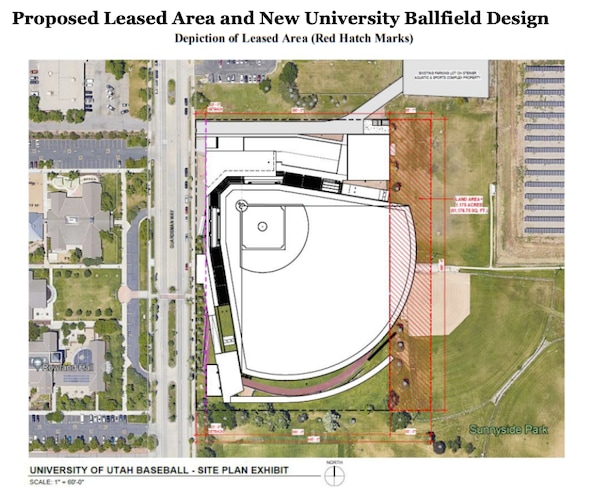The University of Utah has a new home in mind for its baseball team, but if the school wants to build the ballpark of its dreams, it will need to lease left field.
Salt Lake City Council members are scheduled to hear a proposal Tuesday that would allow the U. to lease a strip of the east side’s Sunnyside Park for nearly a century.
In exchange for forking over land that cuts into an existing city softball diamond and multiuse field, the school would give the city $4.2 million for park upgrades.
The neighborhood would also get to avoid a potential eyesore.
“The university has stated that this lease would enable sufficient expansion of the baseball playing field to avoid the need to construct undesirable elements,” a city document says, “such as a 35-foot wall between the western boundary of Sunnyside Park and the ball field.”

(Salt Lake City) A map shows the portion of Sunnyside Park the University of Utah wants to lease for its baseball team's new stadium.
At that height, the left-field wall would be 2 feet shorter than the famous Green Monster in Boston’s storied Fenway Park.
With the Salt Lake Bees preparing to move to South Jordan’s Daybreak and Smith’s Ballpark — the current home of Bees and Utes baseball — facing an uncertain future, the U. wants to build over its current practice field on land it owns along Guardsman Way near Sunnyside Avenue.
The U. would get a bargain lease: a buck a year. The nearly 1.2-acre strip it wants has a market value of nearly $435,000.
Mayor Erin Mendenhall’s administration says council members should go for the deal because the extra millions for Sunnyside upgrades and the possibility of the public being able to use the stadium would benefit the city.
Neighborhood leader opposes
The U.’s pitch is striking out with a number of neighbors, though. In a Jan. 24 email to city officials, Jan Hemming, chair of the Yalecrest Neighborhood Council, wrote that her group “vehemently” opposes the land deal because it would cut into “precious open space” within the park.
Hemming argued the proposal, among other things, contradicts “the intent and spirit” of the east bench’s master plan, ignores community input, breaks a promise the U. gave the neighborhood council in 2018 that it would never build a stadium over the practice field, and violates city code pertaining to the transfer of open spaces (the city contends the lease does comply with code).
The city should halt the transaction, she wrote, especially since the Oakland A’s may be exploring the possibility of playing at the Bees’ yet-to-be-built Daybreak stadium.
“This could lead to the Salt Lake Bees and University of Utah having use of Smith’s Ballpark for three more years — and give the U. additional time to find a more suitable location,” Hemming stated. “In other words, a win-win.”
University spokesperson Christopher Nelson said in an email that the school did not think it would need to replace its existing practice facility on Guardsman Way in 2018. At the time, he said, Smith’s Ballpark was an effective venue.
The goal, he said, was always to bring baseball back to the campus with a preferred location in the central campus.
“That [central] site is now a living-learning facility,” he said. “The Guardsman Way location was then deemed the next best location.”
Like it or not, a ballpark is coming
(Salt Lake City) A rendering shows how Sunnyside Park could be reconfigured if the city leases a strip of the park to the University of Utah for a new baseball stadium.
No matter what the council decides, city records state, a new Utes stadium is coming to the western edge of Sunnyside Park. The only decision in the city’s hands is whether that stadium has a wall to meet NCAA standards for a shortened field or is able to expand enough to eliminate such a barrier from the ballpark’s design.
“The administration’s public benefits analysis found that such a wall would obstruct existing sightlines in Sunnyside Park,” city staffers wrote, “that provide natural surveillance and improve park safety.”
Other benefits, meanwhile, include an infusion of cash to make upgrades to the park, the possibility of allowing the public to access the field when the U.’s team isn’t using it, permitting public access to university-maintained restrooms and concessions, and access to a portion of the leased land, including a proposed berm.
Nelson said the ballpark’s design has yet to be finalized, but a groundbreaking is slated for this spring. The goal, he said, is to have a stadium open in time for the 2025 season.
The council anticipates hosting public comment and casting a final vote Feb. 20.







